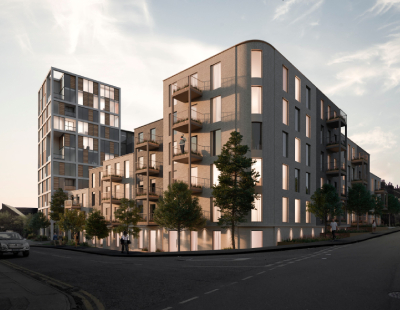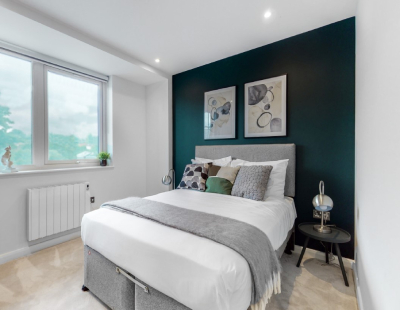Santhosh Gowda, chairman of property developer Strawberry Star, outlines in this guest piece why Luton is really going places and should be on the radar of investors looking for good yields.
From hat making to car factories, Luton’s long industrial history has kept the local economy and housing market here busy. But Luton has transformed itself during the past decade once again, as a global player in today’s technological service industries.
Set right in the middle of the Cambridge-London-Oxford Golden Triangle, Luton has led the charge for the UK’s own Silicon Valley, recently crowned the top city for early-stage start-ups by Fasthosts. Attracting an influx of new businesses in 2021, Luton has proven to have the best rates of production, office prices and business survival rates among other cities, as well as the best-all round UK location for aspirational entrepreneurs. Some already popular tech start-ups based here are AiSolve, Chargemaster, OAG and more.
This technology boom plays a lead role in the town’s future as an active Growth Area. Luton has been the recipient of a £1.5 billion regeneration programme, which includes the Luton Investment Framework: a 20-year plan for major transformation to attract business headquarters, thousands of new jobs and a plethora of new amenities.
Its former hat factory has now been revived in a £10 million project renamed the Hat District and Cultural Quarter: a creative studio space for artists, start-ups and entrepreneurs. The Luton DART and Luton Bypass have led the charge in infrastructure improvements here, with thousands of new homes in the pipeline to support the town's rapid population growth as a result.
And home-movers are cottoning on to this exciting new era for Luton. Investors are piling in, but more tellingly, demand from tenants and buyers has bever been so high. Analysis from property portal Zoopla in December highlights Luton’s pull-factor, crowning it the most popular town in the UK for first-time buyers by volume of searches.
Strawberry Star’s Luton lettings team similarly noted extraordinary levels of demand in the second half of 2021, with an undersupply of quality, modern housing keeping rental values high. Our sales agents tell a similar tale – rising demand from locals looking to upgrade, compounded by a new wave of commuters who feel much less anchored to London.
Stock levels just can’t keep up. This is reflected in the numbers. Zoopla reports demand for rental homes being 43% above the five-year average. Overall, sold prices in Luton over the last year were 7% up on the previous year according to Rightmove, and 15% up on the 2018 peak of £254,628. So, what’s the solution?
Build-to-Rent (BTR) could provide an obvious first answer to this highly pressurised market, as a way to quickly boost much-needed supply and replace some of the private landlords who left the sector after a turbulent pandemic year. BTR can often be an affordable alternative for tenants in the Private Rented Sector (PRS) too, complimented by the amenities on offer which play to modern, urban lifestyle choices, from on-site cafes to 24-hour concierge.
Nearly all BTR schemes are located in cities identified as having increased housing targets, such as Luton, underlining the important role these homes have in meeting our national housing targets. This year saw a near 80% increase of capital invested into the sector compared to 2020. I don’t think it’s unreasonable to suggest investment could triple as we head into 2022, having shown incredibly strong rental resilience during an unpredictable year for the UK economy.
Another clear way to boost supply is to attract traditional buy-to-let (BTL) investors alongside the BTR market. Aldermore’s latest Buy-to-Let City Tracker - which analyses and assesses five key indicators that impact desirability from vacancy numbers and to yield percentages - saw Luton enter the top 10 for the first time this year, rising from 12th to 5th place. It jumped up the rankings in such a short time span thanks to its projected house price growth, with an increase of 5.2% year-on-year since 2011.
Luton now has the strongest property price growth of any of the 50 cities in their report. Similarly, Luton was ranked London’s number one commuter town according to Lloyds Bank, with rental yield projections of up to 5% and annual capital gains at 3.5%. Furthermore, Savills data shows a remarkably positive long term outlook for this underdog town, predicting a 17% increase in house values over the next four years in the Luton region. Meaning essentially, if you buy a property in Luton in 2021, you could see a capital growth rate of 17% by 2025.
For investors, these stats are now more important than ever in an era of increasing property taxes. BTL is still a healthy sector for hobby investors and portfolio landlords alike – but it’s the location of where to buy that could add or subtract a yield percentage, crucially making an investment viable or not.
With increased regulation in the rental market on energy performance, investing in new-build apartments in particular will continue to be the most effective way for landlords to avoid costly upgrades.
*Santhosh Gowda is chairman of property developer Strawberry Star









.png)

.jpg)








Join the conversation
Be the first to comment (please use the comment box below)
Please login to comment